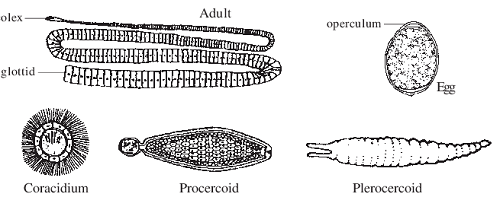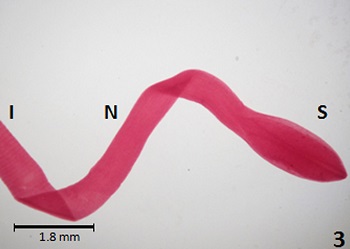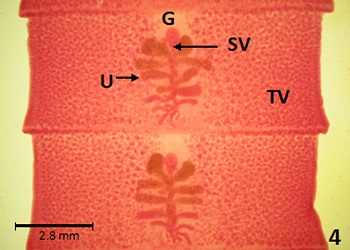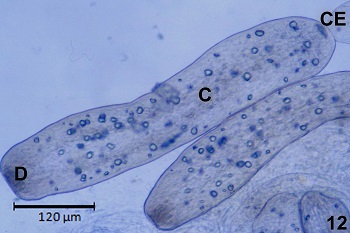Diphyllobothrium latum - Introduction, Classification, History, Habitat, Morphology
Introduction of Diphyllobothrium latum
Diphyllobothrium latum is the most common species of tapeworm which infects humans. It is called a fish tapeworm, a broad fish tapeworm because fish is a common source of infection in humans. It is the longest parasite found in the intestine of man and causes diphyllobothriasis.
The tapeworm infects both fish and mammals.
Classification of Diphyllobothrium latum
Phenotypically, Diphyllobothrium latum is classified as:
Kingdom: Animalia
Phylum: Platyhelminthes
Class: Cestoda
Order: Diphyllobothriidea
Family: Diphyllobothriidae
Genus: Diphyllobothrium
Species: D. latum
History of Diphyllobothrium latum
Historically, Diphyllobothrium latum was first described in 1592 from clinical specimens in Switzerland. Centuries later in 1917, Janicke and Rosen described the parasite's life cycle.
Habitat of Diphyllobothrium latum
Adult Diphyllobothrium latum habitats the small intestine- mainly the ileum or jejunum of humans.

Fig: D. latum morphology (Source: waterpathogens.org)
Morphology of Diphyllobothrium latum
Morphologically, Diphyllobothrium latum can be adult, proglottids, egg, and infective form.
Adult
The adult Diphyllobothrium latum is composed of three fairly distinct morphological segments- the scolex (head), the neck, and the strobila (lower body). It is ivory in shape and measures 10 meters or more lengthwise. The adult tapeworm can live for 5 years to 13 years and produce about 1 million eggs per day.
Scolex
Diphyllobothrium latum scolex is elongated and spoon-shaped
presence of two long, weak grooves or bothria, one ventral, and another dorsal
lacks suckers and hooks
Neck
Diphyllobothrium latum neck is thin and unsegmented
longer than the head
Strobilla
Diphyllobothrium latum strobilla consists of 3000-4000 proglottids (segments)
mature/gravid proglottids are broader than long, measuring 2mm to 4mm in length and 10mm-12mm in width

Image: D. latum - Scolex (S), neck (N), immature proglottids (I) after Semichon´s acetic carmine stain (Source: waterpathogens.org)
Proglottids
Each mature proglottid of Diphyllobothrium latum contain
a bilobed ovary near the rear end of the segments
a central rosette-like uterus
three genital openings- vas deferens, vagina, and uterus
The vas deferens, vagina, and uterus are present close to each other in that order. The gravid proglottids of Diphyllobothrium latum expel the eggs through their uterine pore.

Image: D. latum proglottids - genital atrium (G), seminal vesicle (SV), uterus (U) testes, vitelline glands (TV) after Semichon´s acetic carmine stain (Source: waterpathogens.org)
Egg
Diphyllobothrium latum eggs are light brown in color which are bile stained
oval shaped with measurements around 70μm to 45μm in size
inconspicuous operculum or lid is present at one pole of the egg
a small knob-like projection is present at the other end which may or may not be visible in the unsegmented ovum
freshly passed eggs are not infective to humans

Image: D. latum Procercoids - ducts of glands (D), calcareous corpuscles (C), cercomer (CE) (Source: waterpathogens.org)
Infective form
Plerocercoid
third stage larva of Diphyllobothrium latum is plerocercoid
also known as sparganum
white, unsegmented, and tape-like
measures 10mm in length
not encysted or encapsulated
has a partly invaginated scolex
found freely in the body cavity, muscles, and connective tissues of the fish host